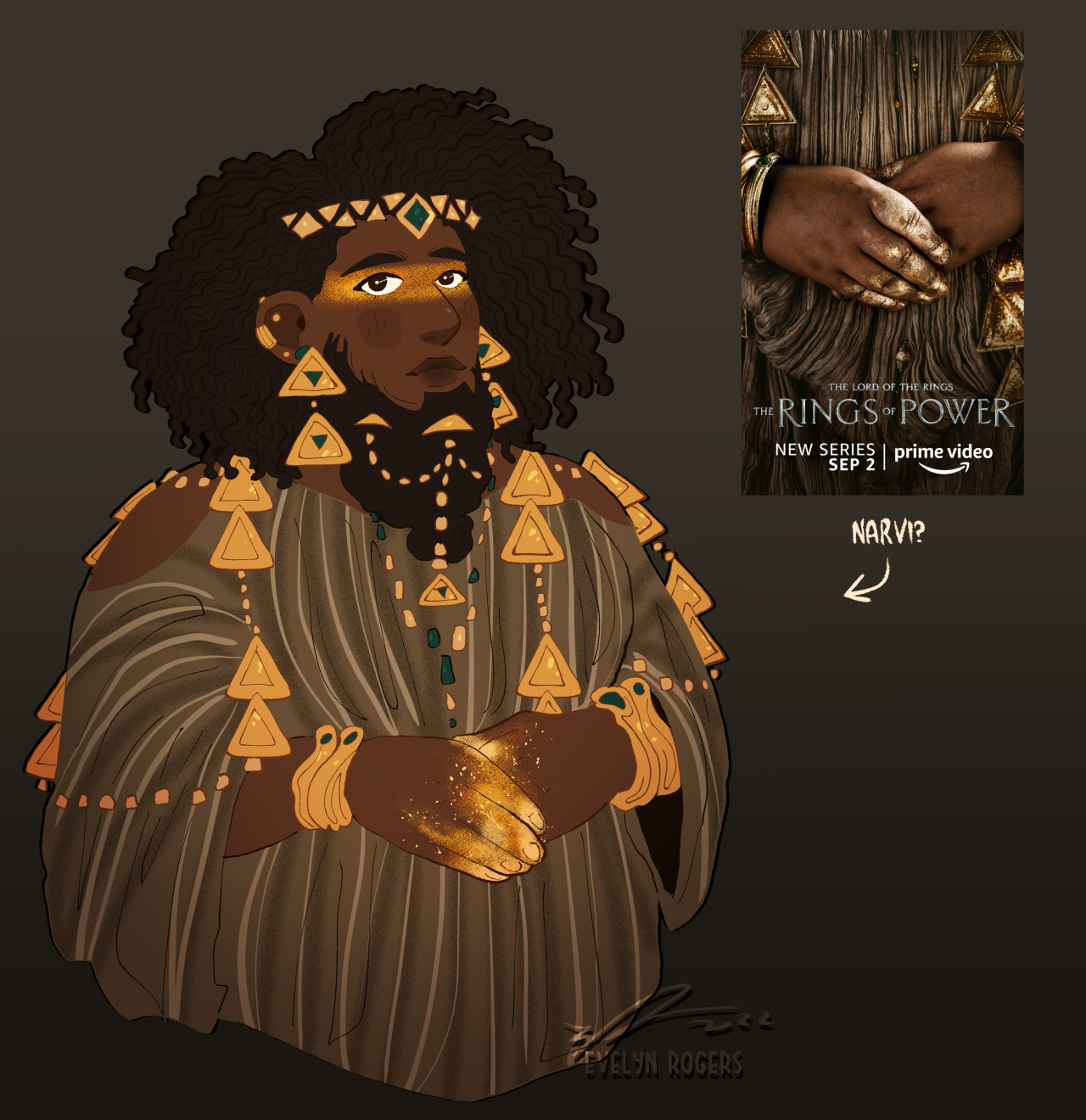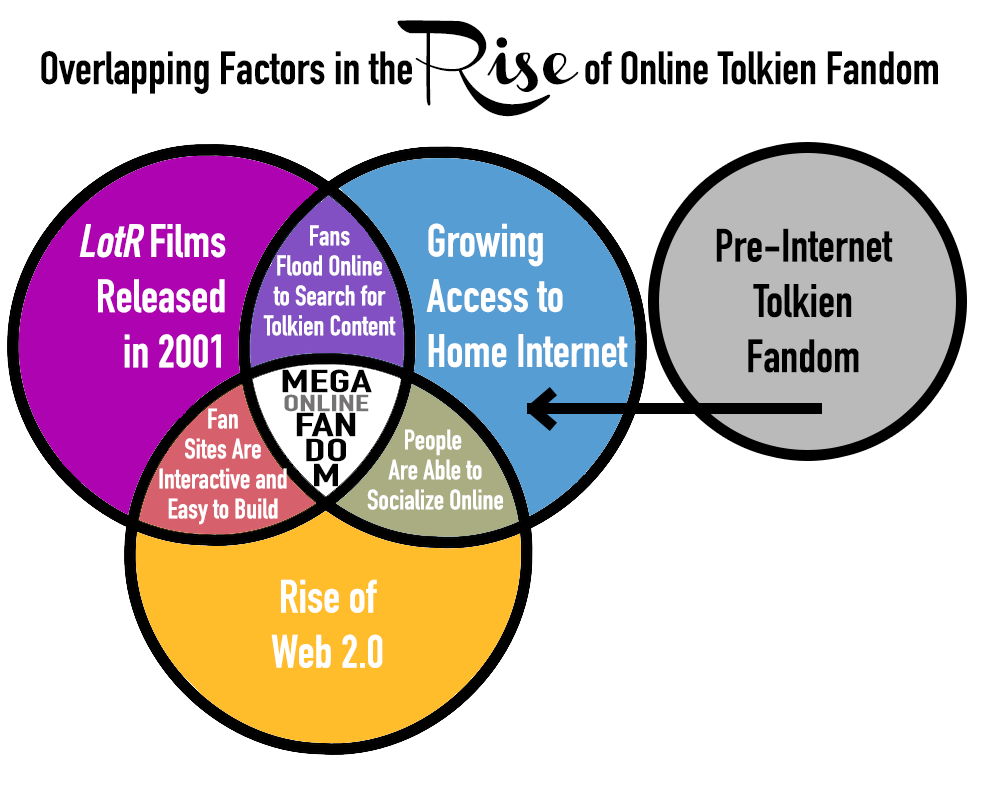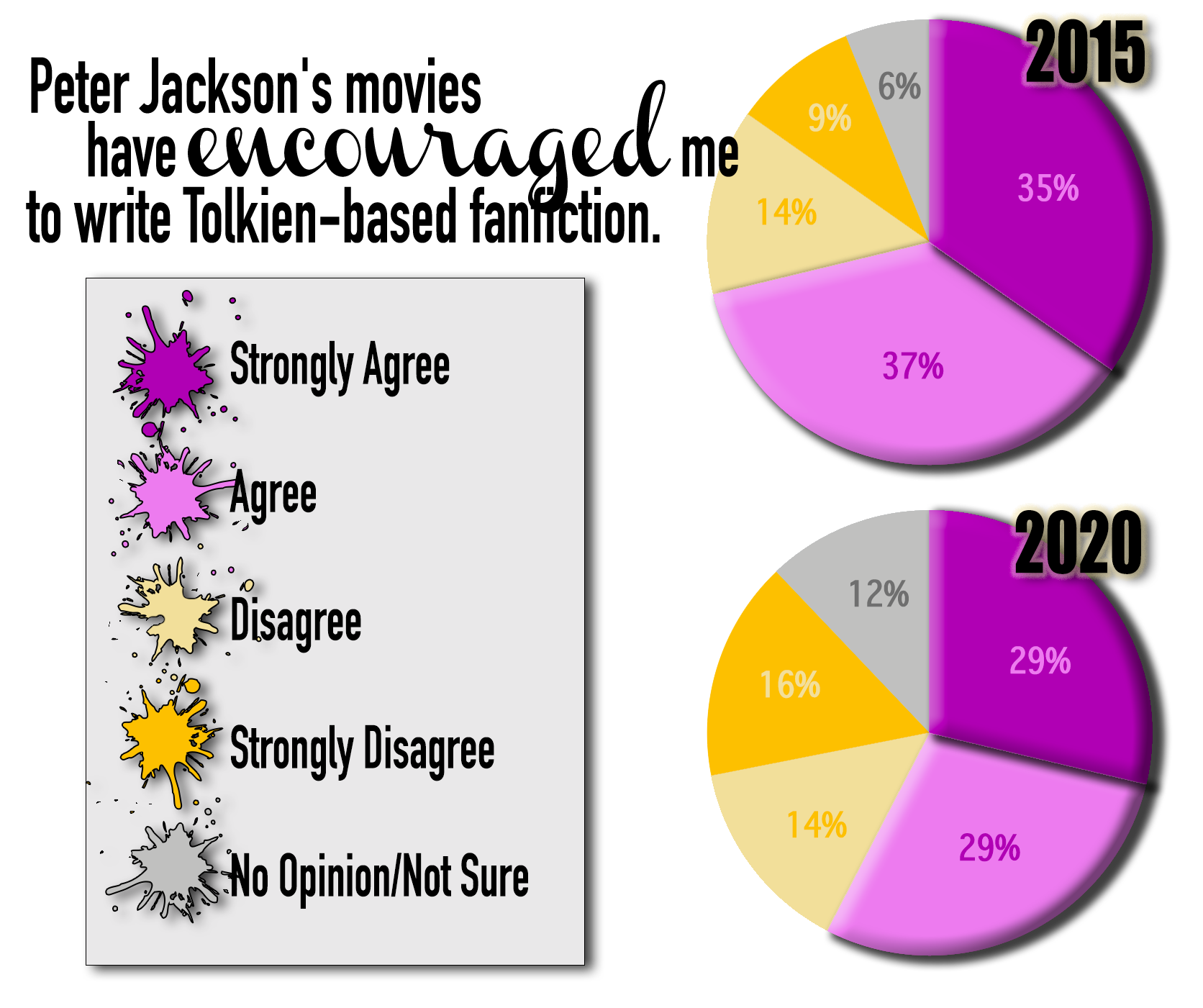Becoming Bookverse: Jackson's Films as an Initiation Point for Tolkien's Book Fandom by Dawn Walls-Thumma
Posted on 26 March 2022; updated on 1 April 2022
This article is part of the newsletter column Cultus Dispatches.

With the new Tolkien-inspired Amazon series The Rings of Power due out on 2 September 2022, many fans are discovering they have big feelings around how the show might impact their beloved fan communities. However, this is not the first time that Tolkien's books have been adapted for the screen. The Lord of the Rings films, after all, are among the most popular films of all time, both in terms of profit and audience reception. The Hobbit films, while not as well received by critics and fans, were nonetheless blockbusters. While I don't have data to back me up here, I think it's safe to say that the vast (VAST) majority of Tolkien fanworks creators have seen at least one of these films, and most have seen all six.
Where I do have data to back me up is how the films have impacted the Tolkien fanfiction community. Now is the time for my usual disclaimer: Data, unless otherwise indicated, comes from my Tolkien Fanfiction Survey, which I first ran in 2015 and again in 2020 (with the assistance of Maria Alberto). "Hard data" can sometimes feel like it's of a higher quality and more factual than other forms of investigating fan cultures, but survey data has many limits and should only be considered in conjunction with other forms of knowledge of fan communities. As always, my data here offers just one perspective on a complex question.
What we see is that, yes, these six films have influenced the Tolkien fanfiction fandom. (Going forward, whenever I say "the fandom"? This is the specific fandom I'm talking about.) However, that influence is complicated, and one can equally make the case that the books have exerted a much greater influence on film fans than the other way around—and probably will for The Rings of Power too.
Over a few columns, I'll explore these data and what they show of how Tolkien fans have used media franchises in the past. I'll look at the Lord of the Rings and Hobbit films and how they influenced (and didn't influence) the fandom. Finally, I'll consider what they can tell us about how the upcoming Rings of Power series may likewise influence the fandom. This week, I'm going to focus on initiation and sources: Why and when fans begin writing fanfiction and the sources they use when they do.
Three for the Elven Kings (Dial-Up, Online Mailing Lists, and a Blockbuster Film Trilogy)
The Lord of the Rings (LotR) films are, in short, a cultural phenomenon: a rare amalgam of sky-high profitability, critical acclaim, and sheer fan adulation. Anecdotally, many fans acknowledge that the LotR films influenced—even generated—how they viewed the appearance of the characters and setting of Middle-earth. But their influence on the fandom is far from straightforward.
First, let's rewind imaginatively back to the year 2001. Several important things happened simultaneously at this time that explain how Tolkien rocketed to mega-fandom status in the early 2000s:
- The LotR films reached hundreds of millions of viewers. Many of them became fans.
- In the United States, while only about half of households had home Internet access, these numbers were rising rapidly.
- Web 2.0—websites designed to allow users to produce content and interact with each other—was swiftly evolving.
Prior to the early 2000s, fandom was largely an offline endeavor, and fannish participation was hardly the norm for most people. There was fanfiction and fanart based on Tolkien's work; there were vibrant fan communities with their own unique cultures. To the uninitiated, however—which would have been most of those new film fans—these offline spaces were difficult or almost impossible to find. Most people wouldn't even know to look—much less where to look. In the diagram below, I represent these pre-Internet communities as near to the rising online fandom but not overlapping it. An arrow points into the online fandom but is unidirectional. In other words, fans from the pre-Internet fan communities could—and did—make the small leap to participating online, but their fanworks were nearly inaccessible to online fans, and their cultures and practices were not universally accepted and, when they were, did not go uncontested. (The perception of slash fanfiction—of which I have found no evidence in the pre-Internet fandom—as uncanonical is perhaps the most prominent example.)

The three factors above interacted to change that. Internet users, many of them online for the first time, took to searching for their interests online. Thanks in a large part to the LotR films, for many of them, Tolkien was one of those interests. And Web 2.0 was in a sweet spot for encouraging fannish activity. Online Tolkien fandom began in the early 1990s with Usenet newsgroups and MUSH servers, and online Tolkien fanfiction arose in the late 1990s with mailing lists and the first fanfiction archives. Forums and mailing lists permitted fans to interact with each other, but the participatory web hadn't evolved to the point of actual social media sites yet. (Sites like Facebook and Twitter that dominate the online landscape today were years away from existing when The Fellowship of the Rings hit theaters.) A few years later, those same fans who spent hours theorizing, arguing, and discussing Tolkien on early Web 2.0 platforms would have shared that time among a greater variety of sites and purposes.
Web 2.0 also meant that fannish spaces were no longer hard to find. By the time the films brought fans online in droves, it was incredibly easy to join a mailing list or forum where one could squee over the films, discuss the book, and share fanworks about both. In fact, Web 2.0 eliminated the need for all but the most basic technical know-how in order to start such an online group—and many fans did. Remove one of these factors and LotR may well not have become the mega-fandom it did.
However, the influence of the films is far from straightforward, and most of those eager new Tolkien fans would stay on to become book fans. The films, while defining the aesthetic of Middle-earth in many ways, would function mostly to springboard fans into the books rather than supplanting them.
The Sights and Sounds of [Peter Jackson's] Middle-earth
Frodo's wide, blue-eyed stare. The serrated peaks and gossamer waterfalls of New Zealand. Galadriel's dulcet contralto voice and Legolas's delicate blond braids. Sauron's fire-rimmed eye swiveling across Mordor like a spotlight announcing a Labor Day doorbuster at the local mattress outlet.
None of these are "canon" in the sense that they come from the books. Yet they are all widely adopted by Tolkien fans based on their use in Peter Jackson's films. Writing about fan films, Miguel Ángel Pérez-Gómez called this "double canon": "canonical aesthetics … assumed by fan creators."1 Amy Sturgis observed something similar when she noted that, even among bookverse LotR fanfiction, authors employed stills from the films to accompany their stories.2 Again, the reason for the dominance of the aesthetics of the films wasn't a lack of existing fanart but that this artwork was either commercial (e.g., John Howe, Alan Lee, and Ted Nasmith) or archived in pre-Internet fannish spaces, such as print fanzines. While Jackson's interpretation of Middle-earth was omnipresent, the fannish take was difficult or impossible to access.
It's also important to note that John Howe, Alan Lee, and Ted Nasmith were all approached to work on the conceptual designs for the LotR films; Howe and Lee ended up working on the project. As all three artists had professionally illustrated Tolkien's work prior to that point, even the "visual canon" for which Jackson is so often credited ultimately originated from the work of artists inspired by the books.
Of the Rings Books of Power
Yet anyone who participated in the fandom in the early 2000s can tell you that the films did not go uncontested in other areas of fannish expression. (They didn't go entirely uncontested in terms of aesthetic canon either, but even two decades later, many fans will tell you they have trouble imagining the look of Middle-earth as anything but Jackson's Middle-earth, even when his aesthetics contradict the texts. The same number of fans are not clinging to the Galadhrim at Helm's Deep or knocking Glorfindel out of the story. I'll discuss how fans actually use the films in a later column.)
The reason, of course, is the books.
There is often an assumption (or maybe anxiety) that media texts will dominate the written texts in the fandom. This is not the case in the Tolkien fanfiction fandom. After all, if there is a cultural phenomenon bigger than the LotR films, it is the LotR books, which are widely regarded as one of the greatest books of the 20th century and the cornerstone of the modern fantasy genre. Millions of people had read and loved Tolkien's books before the films were released. These people flooded online to talk Tolkien right alongside people who had first set foot in Middle-earth through Jackson's films. And while most people who had read and even considered themselves fans of the books were not in fandom, people who were in the pre-Internet Tolkien fandom were eager to participate online as well. Fans came together from all of these points of entry after the release of the LotR films to form the online fandom.
While the films largely kindled the sudden interest in Tolkien fanfiction online, survey data shows that it was the books that sustained it.
In both the 2015 and 2020 surveys, I asked authors to respond to the statement, "Peter Jackson's movies have encouraged me to write Tolkien-based fanfiction." Participants were given five choices: Strongly Agree, Agree, Disagree, Strongly Disagree, and No Opinion/Not Sure. In both surveys, more than half of participants agreed or strongly agreed with the statement.

The 2020 survey also included the item, "I started writing Tolkien-based fanfiction because of Peter Jackson's movies (either The Lord of the Rings or The Hobbit trilogy)." Forty-four percent of participants agreed or strongly agreed with this statement.

These two sets of data show that the films bring fans to the fanfiction community and encourage them to write stories set in the Ardaverse. But, for those fans who remain in the fandom, this is only the first step. Filmverse-only fans were exceedingly rare in both the 2015 and 2020 surveys. In 2015, only 0.5% of fans used only the films as sources; in 2020, only 0.8% of fans were filmverse-only writers. Put another way, if you put two hundred Tolkien fanfiction writers in a room, you might find one who writes using just the films. The other 199 authors use one or more of the books.
And usually more than one book. The data for both 2015 and 2020 show that, the longer a person remains in the fandom, the more books they use in their fanfiction. While nearly all authors, no matter their experience level, use the LotR books, as their time in the fandom grows, they expand upon what they read and use in their stories, until by Year 16, a majority of authors are using The Hobbit and LotR, as well as The Silmarillion and the History of Middle-earth and/or Unfinished Tales.

Despite the blockbuster films and despite their influence in encouraging fic writing, the Tolkien fanfiction fandom is ultimately a book fandom. Fans may be brought to the fandom by the films, they may adore the films, they may even write about the films—but nearly all of them will end up writing about the books too, and the books will become central to their stories.
A [Less] Warm Welcome: The Hobbit Films
Of course, when we talk about "the films" and their influence on the fanfiction fandom, we are actually talking about two trilogies that were about a decade apart. Not surprisingly, the LotR and Hobbit film trilogies impacted the fandom in different ways. While the Hobbit films were clearly influential in key ways—how Dwarves were depicted, for one, and the force of nature that is Bagginshield—the LotR films are generally more impactful.
To begin with, more survey participants used the LotR films as sources for their fanfiction than use the Hobbit films—this is in spite of the fact that the Hobbit films were more contemporaneous with both iterations of the survey. In the 2015 survey, as the Hobbit trilogy was exiting theaters, 60% used the LotR films for their fanfiction, compared to just 51% for the Hobbit films.
Five years later, the LotR films show a staying power with fanfiction writers. In the 2020 survey, 56% of authors used the LotR films, a decrease of just four percentage points in five years. In comparison, just 37% used the Hobbit films, a drop of fourteen percentage points from five years previous.
Even among authors who started writing3 while the Hobbit trilogy was in theaters, the LotR trilogy was more influential: 56% of them used the LotR films compared to just 39% using the Hobbit films. Notice that these data match the numbers for authors as a whole, showing that the films that would have likely dominated their fandom experience as new fanfiction authors didn't influence their writing anymore than authors who started writing before or after the Hobbit trilogy. Whether this is because they eventually centered the books, or because fans who focused on the films found the fandom less receptive to their interests and moved on is uncertain. Either explanation points to the dominance of the books in the fandom.
I suspect the reason the Hobbit films have less of an impact is multifold. For one—and I mean no offense to fans of the Hobbit films—the Hobbit films did not command the popular and critical acclaim of the LotR films. Without denying that they entertained and inspired many Tolkien fans, they lack the aesthetic force of the LotR films that allowed the LotR films to define Middle-earth for many people (in part because they themselves were an extension of that same aesthetic).
But there is also the timing. Recall that the LotR films arrived in a fandom that was just moving online. This nascent online fandom lacked the compendium of visual, fictional, and meta fanworks that would shape later fans' vision and understanding of Tolkien's world. Furthermore, while online fanfiction burgeoned during the years of the LotR film trilogy, home Internet was still rudimentary in those years, and sharing multimedia such as art, audio, and video was difficult or even impossible. The fandom was, in many ways, a tabula rasa, leaving Jackson's vision in the LotR trilogy to go almost uncontested among fans entering the fandom.
The exact opposite was the case during the Hobbit trilogy. Fans who joined the fandom during those years had access to an Internet that easily accommodated text, images, audio, and video. When they made their first forays into Tolkien fanworks, they found hundreds of thousands of stories, meta, works of art, and other fan productions, as well as extensive "fanon" that often governed how characters, places, and events were depicted and discussed in the fandom—all without the involvement of a single publisher or media corporation. Most importantly, as discussed above, those fanons were by and large developed by fans using the books as their sources. In short, the Hobbit films had to compete with fanworks for the appeal to and interest of new fans in a way that the LotR films, at the advent of the online fandom, did not.
Welcome to the Jungle? Predicting the Impact of The Rings of Power
Two film trilogies remove some of the mystery of how the Rings of Power series will impact the Tolkien fanfiction community. First and most importantly, a media adaptation—even a wildly successful one—does not necessarily dominate a book fandom. Furthermore, by the time the first episode airs, the online Tolkien fanfiction community will have been going strong for more than twenty years. Comparing the impacts of the LotR and Hobbit trilogies, this appears to be at least part of the reason why the Hobbit films didn't influence fanfiction to the extent that the LotR films did.
However, the Amazon series is a show and not a film, which introduces the possibility that it won't behave exactly as a third film trilogy might have. As I considered how The Rings of Power might differ from a film trilogy, a few key differences came to mind.
There's potential for a lot more content. A LOT.
While details at this point remain slim, it appears that Amazon contracted for at least five seasons, with the first season at eight weekly episodes. Assuming these numbers pan out, that's a baseline of forty hours, more than double that of the two film trilogies combined. And the aforementioned sources report the option of extending the franchise even further if it proves successful.
But the audience will very likely be smaller.
However, the audience for a streamed show appears to be much slimmer than that for a feature film. Game of Thrones, easily the most popular television fantasy series as of this writing, engaged a record-breaking 19.3 million viewers for its final episode. Yet Return of the King, in 2003, sold about 142.6 million tickets worldwide.
These data aren't perfect comparisons. Plenty of people tuned in to Game of Thrones after the hype had died down, but plenty of people have also watched Return of the King at home who didn't catch it at the theater. Regardless, films seem to draw larger crowds than streamed shows, which isn't a surprise, since people mildly curious about a production are more likely to take a chance on a movie ticket than to subscribe to a streaming service they don't already have. In 2021, Amazon Prime passed 200 million subscribers, which means that if most of them check out the Rings of Power series, the show could come close to the box office numbers for Return of the King. (But most of them won't.)
Of course, Amazon is hoping to bolster that 200 million subscribers with The Rings of Power, but it seems safe to say that films attract a wider audience than streamed television shows.
Amazon's reliance on original characters has the potential to generate fanworks.
Finally, there is the content of the show itself. Building on material from the appendices of LotR, the new show will be by necessity more inventive than the Jackson trilogies, which (more or less) followed the storyline of their respective books. It is possible that introduction to original characters may lead to some fans building out their fanfiction in directions that the books can't follow—but then, Jackson wasn't a stranger to original characters either, and given her centrality to the Hobbit films, there is no great flood of fanfiction about Tauriel. (As of this writing, there are 1,844 stories on AO3 tagged with Tauriel as a character out of 18,511 stories tagged The Hobbit (Jackson Movies).) On the other hand, a heavy reliance on original characters also means that canon characters won't be subject to revision, as in Jackson's controversial canon-contrary depictions of characters like Faramir and Denethor.
The showrunners are also under the sway of Jackson's aesthetic.
Stylistically, The Rings of Power aim to create a measure of continuity with Jackson's films. Vanity Fair reports that the show's creators aimed for an aesthetic similar to Jackson's, even casting actors who could reasonably look like younger versions of the actors cast in the two film trilogies. This speaks to the power of the visual canon created by the original LotR films. Recall that this is the chief influence of the LotR films that both fans and scholars often identify. In this way, The Rings of Power only expands upon that existing visual canon rather than creating a competing aesthetic that could create friction in or even bifurcate the fandom. Furthermore, the showrunners worked with Tolkien scholars and the Tolkien Estate to ensure that, as show creator J.D. Payne told Vanity Fair, "the ways we connected the dots were Tolkienian and gelled with the experts’ and the estate’s understanding of the material."
Which means the showrunners, like Jackson, also pay a measure of homage to—you guessed it—the books.
Fans initially feared that the show might be used to deliver Game of Thrones levels of sex and violence peppered with names from the appendices. Were this the case, it is very possible that fans drawn in by the show find little interest in books that barely hint at sex and swaddle their bloodiest scenes in poetic prose. Instead, the showrunners' approach seems similar to that of Jackson and his team in desiring coherence with the books—which may well have the same effect as the films have so far in drawing fans into the fandom and driving them toward the books like Saeros before an angry Túrin.
All this brings us to the Third Age of major media adaptations.
Given all of the above, if I were to predict the impact of the Rings of Power show, it would be this: It will be less accessible than the films and will exert no impact on many people in the fandom as a result. Expect stories about original characters from the show—especially if the actors are hot (remember Figwit?)—and a continuance of the aesthetic that Jackson established. And finally—and most importantly—expect a new wave of fans eager to read and learn and write about Middle-earth … from the books.
Acknowledgements
Thank you to Grundy, Himring, Independence1776, Lyra, and Zhie for their comments and feedback on the first draft of this article.
Works Cited
- Miguel Ángel Pérez-Gómez, "Walking Between Two Lands, or How Double Canon Works in The Lord of the Rings Fan Films" in Fan Phenomena: The Lord of the Rings, ed. Lorna Piatta-Farnell (Bristol: Intellect Books, 2015).
- Amy Sturgis, "'Make Mine Movieverse’: How the Tolkien Fan Fiction Community Learned to Stop Worrying and Love Peter Jackson” in Tolkien on Film: Essays on Peter Jackson’s The Lord of the Rings, ed. Janet Brennan Croft (Altadena, CA: Mythopoeic Press, 2004).
- These authors had been writing for five to eight years at the time of the 2020 Tolkien Fanfiction Survey.


Amazon series predictions
Interesting data and conclusions about the possible impact of the Amazon series on Tolkien fandom. Here's hoping that what it brings is enthusiastic new writers (and readers) to the bookverse. Fascinating read!
Thank you! ^_^ I will join…
Thank you! ^_^ I will join you in that hope!
Fascinating read! I…
Fascinating read! I discovered Tolkien through the LotR movies myself and it's interesting to see that my 'journey' through Tolkien's works is far from unusual. I'm cautiously looking forward to the Rings of Power series and I hope that whether I end up liking it or not, it will bring a lot of new people to the books.